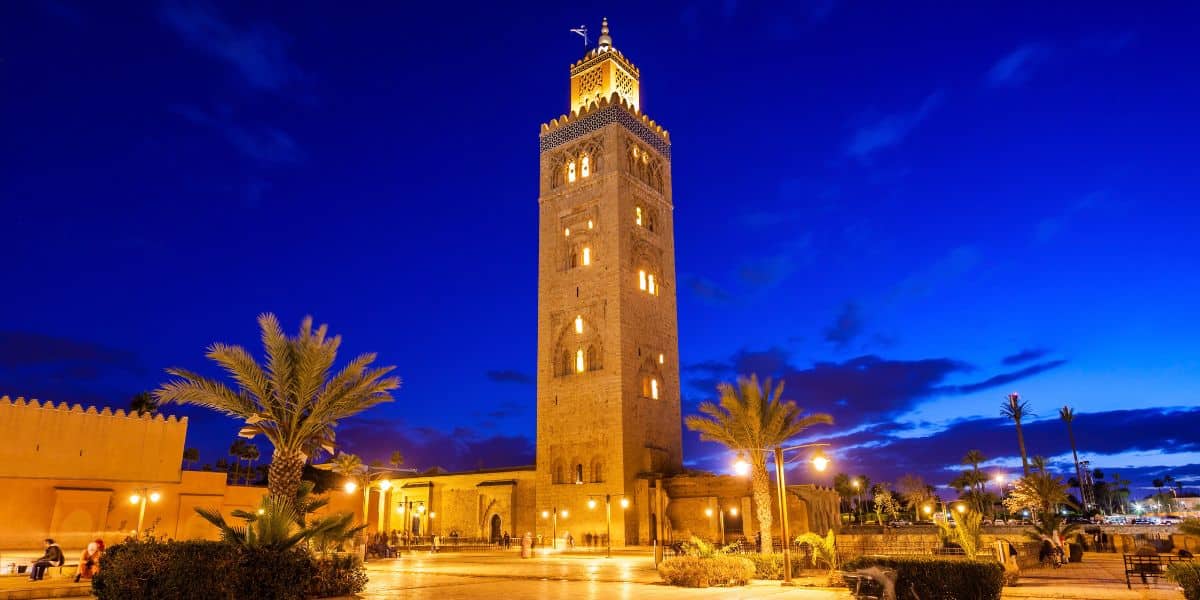
The Story of the Koutoubia Mosque: Marrakech’s Iconic Landmark
Exploring History and Majesty: Unveil the Secrets of Marrakech’s Treasured Minaret.

The Koutoubia Mosque: A Symbol of Marrakech
Standing tall at 77 meters, the Koutoubia Mosque is not only Marrakech’s most iconic landmark but also a masterpiece of Islamic architecture. Its towering minaret, visible from almost anywhere in the city, has been a guiding beacon for travelers and a source of inspiration for centuries. But the Koutoubia is more than just a beautiful structure—it’s a symbol of Marrakech’s rich history, spiritual significance, and cultural identity. Let’s uncover the story behind this treasured monument.
1. A Brief History of the Koutoubia Mosque
The Koutoubia Mosque was built in the 12th century during the reign of the Almohad Caliph Yaqub al-Mansur. Its name, Koutoubia, derives from the Arabic word for booksellers (kutubiyyin), as the area around the mosque was once a bustling marketplace for manuscripts. The mosque was constructed on the site of an earlier Almoravid mosque, and its design reflects the Almohad dynasty’s architectural prowess.
- The mosque was completed in 1199 and has remained a central part of Marrakech ever since.
- Its minaret served as a model for other famous towers, including the Giralda in Seville and the Hassan Tower in Rabat.
- The Koutoubia is one of the largest mosques in Morocco, capable of accommodating up to 25,000 worshippers.
2. Architectural Marvels of the Koutoubia
The Koutoubia Mosque is a stunning example of Almohad architecture, characterized by its simplicity, symmetry, and intricate ornamentation. The minaret, in particular, is a masterpiece of design and engineering.
- The minaret features four copper globes, which legend says were made from the melted jewelry of Yaqub al-Mansur’s wife as a gesture of repentance.
- Its façade is adorned with carved stone, geometric patterns, and Arabic calligraphy.
- The mosque’s interior, though off-limits to non-Muslims, is said to be equally breathtaking, with horseshoe arches, marble columns, and ornate stucco work.
3. The Spiritual Heart of Marrakech
As one of the city’s most important religious sites, the Koutoubia Mosque holds deep spiritual significance for Marrakech’s residents. Its call to prayer, heard five times a day, echoes through the medina, reminding locals and visitors alike of the city’s Islamic heritage.
- The mosque’s minaret is equipped with loudspeakers that broadcast the adhan (call to prayer) across the city.
- It serves as a gathering place for worshippers during Friday prayers and religious festivals.
- The Koutoubia’s presence is a constant reminder of Marrakech’s role as a center of Islamic learning and culture.
4. The Koutoubia Gardens
Surrounding the mosque are the lush Koutoubia Gardens, a peaceful oasis in the heart of the bustling city. These gardens offer a serene escape and a perfect vantage point to admire the mosque’s grandeur.
- Stroll through the gardens’ pathways, lined with orange trees, palms, and fragrant flowers.
- Enjoy a quiet moment by the fountains, which reflect the minaret’s towering silhouette.
- Visit at sunset to see the mosque illuminated against the evening sky.
5. Legends and Mysteries
The Koutoubia Mosque is steeped in legends and mysteries that add to its allure. One of the most famous tales involves the minaret’s copper globes, which are said to have been crafted from the jewelry of Yaqub al-Mansur’s wife as a symbol of her repentance. Another legend claims that the mosque’s minaret was designed to align perfectly with the Kaaba in Mecca.
- Some believe that the mosque’s minaret contains hidden chambers filled with treasures.
- Others say that the mosque’s construction was guided by divine inspiration.
- These stories, whether true or not, contribute to the Koutoubia’s mystique.
6. The Koutoubia’s Influence on Moroccan Architecture
The Koutoubia Mosque has had a profound influence on Moroccan and Islamic architecture. Its design elements, such as the horseshoe arch and geometric patterns, can be seen in other iconic structures across the country.
- The minaret’s design inspired the construction of the Giralda in Seville, Spain.
- Its use of local materials, like red sandstone, set a precedent for Moroccan architecture.
- The mosque’s layout and proportions have been studied and replicated in mosques worldwide.
7. Visiting the Koutoubia Mosque
While non-Muslims are not permitted to enter the mosque, the exterior and surrounding gardens are well worth a visit. Here’s how to make the most of your experience:
- Admire the mosque’s exterior from the gardens or nearby rooftops.
- Visit at different times of the day to see the minaret in varying light.
- Combine your visit with a trip to Jemaa el-Fnaa, just a short walk away.
Tips for Respecting the Koutoubia Mosque
To ensure a respectful and meaningful visit, keep these tips in mind:
- Dress modestly when visiting the mosque and its surroundings.
- Be mindful of prayer times and avoid loud conversations or disruptions.
- Ask for permission before taking photos of worshippers or the mosque’s interior (if accessible).
Final Thoughts
The Koutoubia Mosque is more than just a landmark—it’s a testament to Marrakech’s enduring spirit and cultural heritage. Its towering minaret, intricate design, and spiritual significance make it a must-see for anyone visiting the Red City. Whether you’re admiring its beauty from the gardens or listening to the call to prayer echo through the medina, the Koutoubia Mosque is sure to leave a lasting impression. So, take a moment to pause, reflect, and appreciate the majesty of this iconic symbol of Marrakech.
